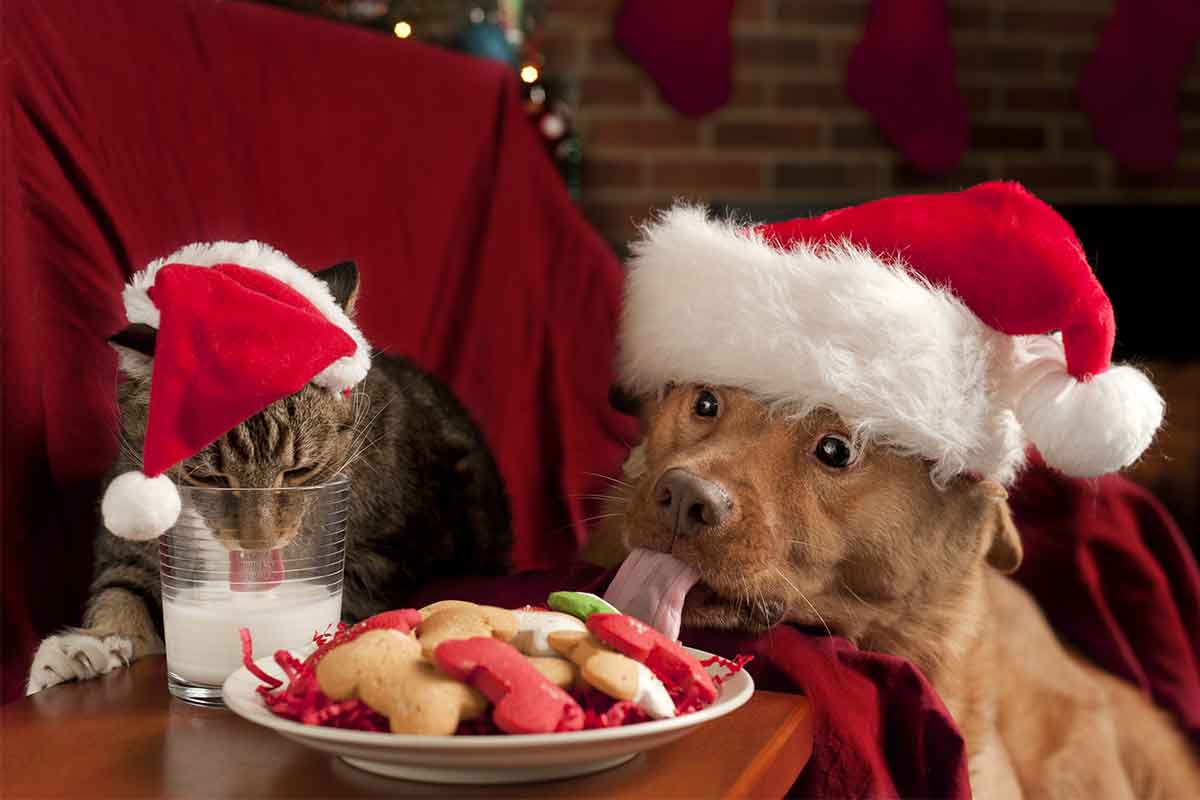Dangling ornaments. Rich food. Brightly blooming plants. Parties. No matter what your species—human, canine or feline—there’s a lot to love about the holidays. But in the wrong hands, er, paws, those same things can cause everything from a bellyache to a bite to a trip to the emergency room. Here are three ways to avoid common mistakes that turn holidays from happy to horrible.
Room To Chill
Some dogs and cats love the comings and goings of the holidays—visitors, parties, package deliveries—but others would just as soon not have their routine disrupted, their heads patted by strangers, or the doorbell ringing constantly to signal the arrival of cards and presents.
Whether you have a social butterfly who enjoys greeting guests or an introvert who lies low during any hustle and bustle, provide pets with a sanctuary room where they can relax if things become overwhelming. Stock it with a Snuffle Mat strewn with puffed rice or O-shaped cereal, a Kong stuffed with goodies, and some interactive toys.
If your dog or cat becomes overstimulated by the presence of non-family members or large numbers of people, it’s okay to not invite him to the party, especially if stress and anxiety could cause him to deliver a bite or scratch.
Set up his sanctuary room as far from the festivities as possible. Dampen sounds by turning on a white-noise machine or playing an audiobook (try Charles Dickens’s “A Christmas Carol” read by Tim Curry) or classical Christmas music. Plug in a pheromone diffuser to fill the air with calming chemicals that mimic the soothing natural pheromones emitted by mother dogs and cats.
Train Guests
We tend to think of our pets as the ones who need training, but human guests may be more in need of it. Not everyone is pet-savvy. Alert arrivals to house rules regarding pets: don’t let them run out the door, always close the gate fully, don’t leave food or drink within reach, don’t offer food from the table, or whatever other standards apply in your home.
Guests who are completely unfamiliar with dogs or cats may be uncomfortable around them or unsure of how to interact with them. Show them how your pet likes to be touched—or let them know if she doesn’t—advise them not to stare, remind them to watch where they step, and alert them to foods that are toxic to pets, such as chocolate, grapes, cooked bones, or anything containing the sugar substitute xylitol. Be sure they know that rich, fatty foods such as gravy and stuffing can be a recipe for life-threatening pancreatitis.
Ask if wrapped gifts contain food. Put food gifts you don’t want your pet to “unwrap” behind closed doors, not under the tree.
Talking Plants
Place holiday greenery out of reach or decorate with artificial plants. At best, pets nibble on live décor and then throw up, usually in the middle of your tree-trimming party. At worst, plants such as mistletoe, holly, lilies, and amaryllis can cause mild to severe vomiting, diarrhea, abdominal discomfort, difficulty breathing, and even death if a pet eats their berries, leaves, or bulbs. Mistletoe is especially toxic and can kill within hours.
Tie down the tree. To protect it from being knocked over by playful dogs or climbing kittens, use fishing line to anchor the tree to the ceiling or wall. You may also want to surround the tree with an exercise pen or other barrier to prevent pets from chewing electrical cords. To further discourage chewing, encase cords in sturdy cable covers. Avoid decorating with tinsel or ribbon, which can be damaging or even deadly to pets if swallowed.
Safety matters, but an equally important way to keep holidays happy and pet-friendly is to maintain a normal schedule as much as possible, especially when it comes to mealtimes, walks, and playtime. You may be busy, but your pet isn’t. Spend a few minutes one-on-one with her every day. She’ll appreciate the attention, and you’ll benefit from the downtime as well.
This article was reviewed/edited by board-certified veterinary behaviorist Dr. Kenneth Martin and/or veterinary technician specialist in behavior Debbie Martin, LVT.








